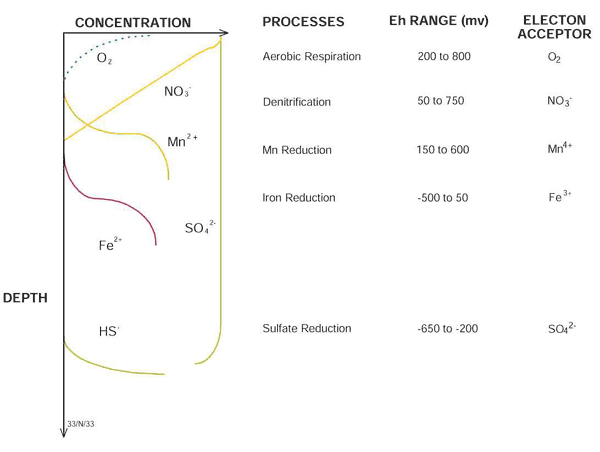Decomposition of organic matter
The decomposition of organic matter is variously referred to as oxidation, metabolism, degradation and mineralisation. Organic matter is first oxidised by molecular oxygen, and the products (or metabolites) of the reaction are carbon dioxide and recycled nutrients (i.e. the reaction is the reverse of photosynthesis) [1,2].
For example, the aerobic respiration of Redfield organic matter yields 106 moles of carbon dioxide (CO2), 16 moles of ammonia (NH3) and one mole of orthophosphate (PO4) (reaction 1). If sufficient dissolved oxygen is present, bacteria oxidise the NH4 produced in reaction 1 to nitrite (NO2) (reaction 1a) and then to nitrate (NO3) (reaction 1b) in a process called nitrification.
(1) Oxygen reduction
106(CH2O)16(NH3)(H3PO4) + 106O2 = 106 CO2 + 16 NH3 + PO4
(1a) 16 NH4+ + 24 O2 = 16 NO2– + 16 H2O + 32 H+
(1b) 16 NO2– + 8 O2 = 16 NO3
106(CH2O)16(NH3)(H3PO4) + 138 O2 ——- 106 CO2 + 16 HNO3 + H3PO4 + 122 H2O
When dissolved oxygen is depleted, oxidation proceeds in a series of reactions which represent successively lower pE levels (or redox states; Figure 1). Reactions 2 – 4 occur under sub-oxic conditions.
(2) Manganese reduction
106(CH2O)16(NH3)(H3PO4) + 236 MnO2 + 472 H+ ——- 106 CO2 + 236 Mn2+ + 8 N2 + H3PO4 + 366 H2O
(3a) Nitrate reduction by denitrification
106(CH2O)16(NH3)(H3PO4) + 94.4 HNO3 ——-106 CO2 + 55.5 N2 + H3PO4 + 177 H2O
(3b) Dissimilatory nitrate reduction to ammonia
106(CH2O)16(NH3)(H3PO4) + 84.8 HNO3 ——-106 CO2 + 42.4 N2 + 16 NH3 + H3PO4 + 148.4 H2O
Iron and sulfate are the last oxidants in the series. Sulfate reduction (5) only occurs under anoxic conditions.
(4) Iron oxyhydroxide reduction
106(CH2O)16(NH3)(H3PO4) + 212 Fe2O3 (or 424 FeOOH) + 848 H+ ——- 106 CO2 + 16NH3 + H3PO4 + 742 H2O + 424 Fe2+
(5) Sulfate reduction
106(CH2O)16(NH3)(H3PO4) + 53SO42- ——- 106 CO2 + 16 NH3 + H3PO4 + 106 H2O + 53 S2-

Figure 1. Schematic representation of chemical processes with depth in sediment and changes in Eh range (Modified after Millero, 1996) [3]
- Froelich, P. N., Klinkhammer, G. P., Bender, M. L., Luedtke, N., Heath, G. R., Cullen, D., Dauphin, P., Hammond, D., Hartman, B., and Maynard, V. (1979). Early oxidation of organic matter in pelagic sediments of the eastern equatorial Atlantic; suboxic diagenesis. Geochimica et Cosmochimica Acta Pergamon, Oxford. 43, 1075-1090.
- Drever, J.I. 1982. The Geochemistry of Natural Waters, Prentice-Hall, Inc., Englewoods Cliffs, N.J., pp. 388.
- Millero, F.J. 1996. Chemical Oceanography. CRC Press LLC. pp. 469.


